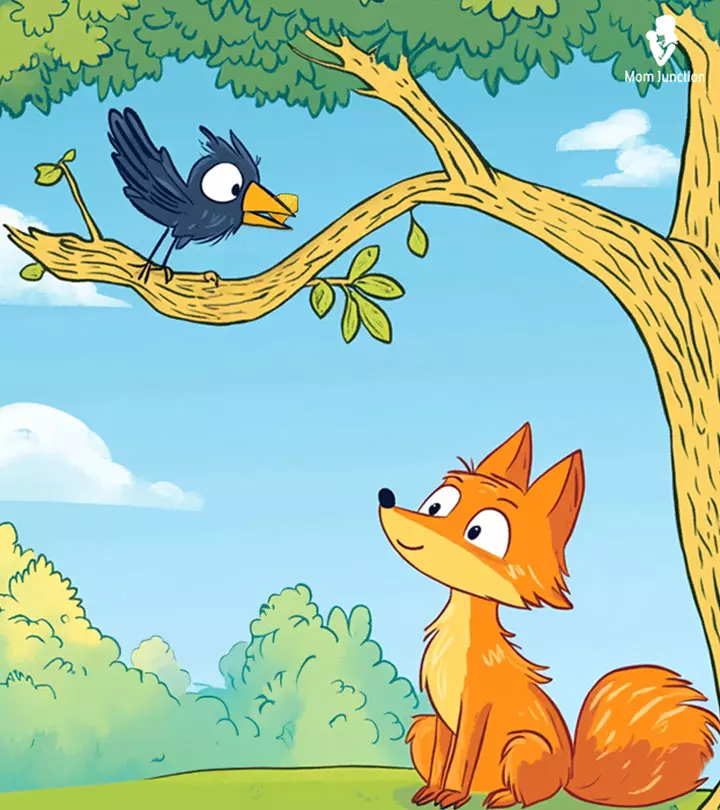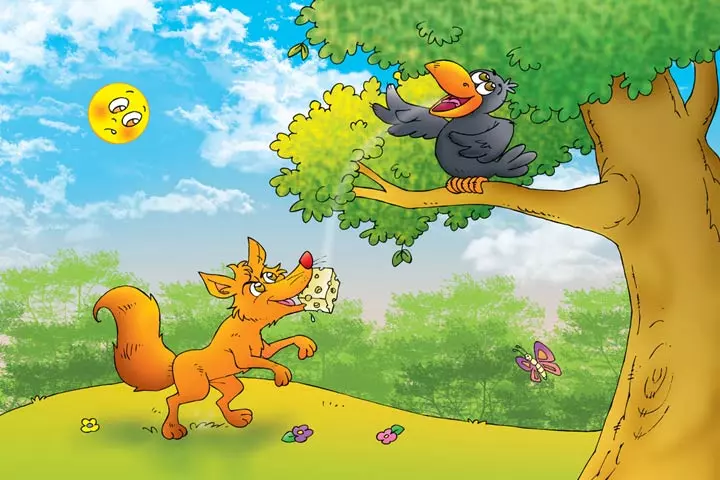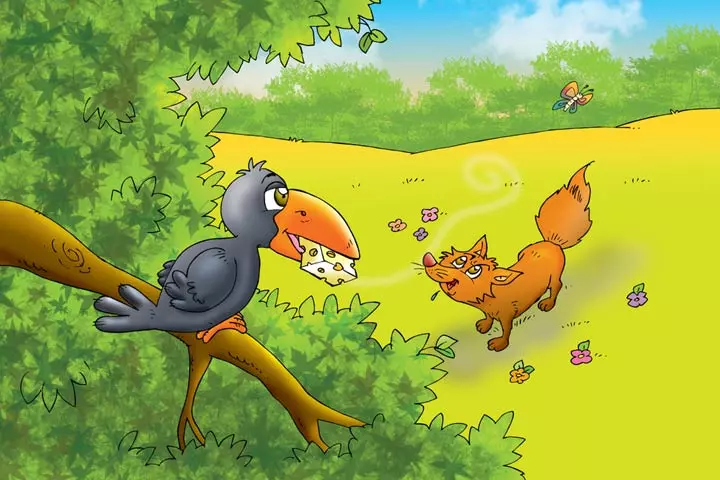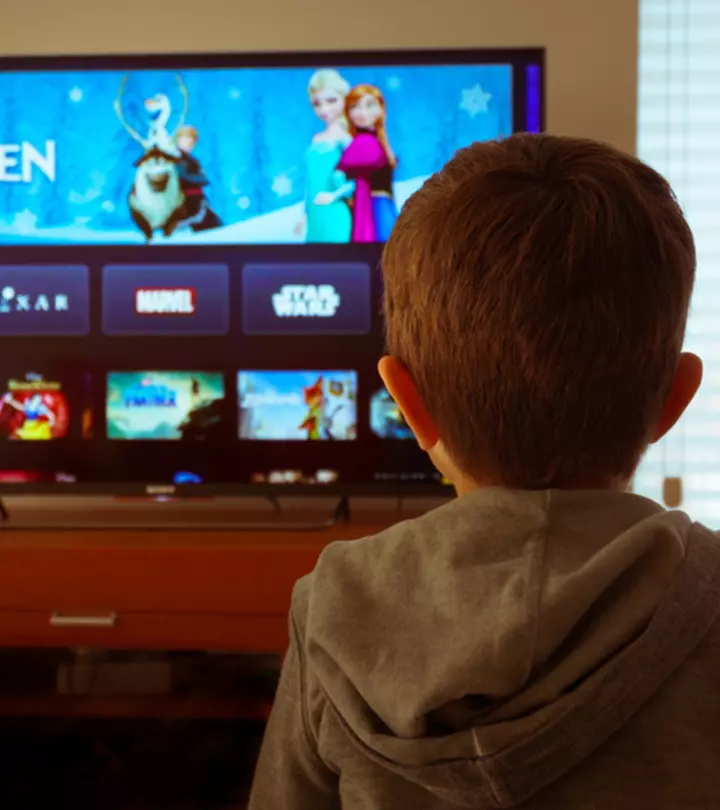
Image: Midjourney/ MomJunction Design Team
Stories take kids into the world of fantasy and entertainment. Aesop’s fables are short and crisp and come with valuable lessons that encourage moral development in children. In this post, we bring you a fox and crow story for kids from Aesop’s fables. It has a lesson and can be a great way to teach children about the world. Grab a snack and enjoy reading this famous parable.
Key Pointers
- Aesop’s fables have always been popular among children for their short and crisp storyline.
- The Fox and Crow story is a gripping fable that teaches children an important moral lesson.
- The story is about the sly fox who uses his cunningness to fool the crow.
- You may tell this during a camping night, or it may serve as a bedtime story.
The Fox And The Crow Story
On a beautiful morning, a wily fox strolls sniffing around in the forest. In search of something to munch on, he spots a crow sitting on a branch of a giant tree.
A bite of cheese held by the crow in its beak catches the attention of the fox.
In the first instance, the fox does not pay much attention. But when he looks at the crow for the second time, his resourceful, cunning mind starts thinking of ideas for stealing the cheese bite.
“I need not wander anymore to find my breakfast; who wouldn’t like to have a piece of yummy cheese,” thinks the crafty fox.
He walks up to the foot of the tree and tries to strike a conversation with the crow.
“Good morning, you beautiful crow,” said the fox in a pleasant voice.
The crow looks at the fox suspiciously and tightens her grip on the cheese, wary of his slyness. She does not respond to fox’s greetings.
The mischievous and shrewd fox continues to flatter the crow, he says:
“What a beautiful bird you are! Such silky and shiny feathers.
You are a bird with spectacular wings.”
The crow falls for it.

Image: Shutterstock
The keen and astute nature of the fox enables him to notice a change in the crow’s expression; the fox then tries to woo her one more time through trickery by saying:
“Such a pretty crow must have a pleasant soothing voice.
Can I request the queen of all birds, crow, to please sing a song for me?”
 Quick tip
Quick tipThe initially skeptical crow now forgets all her suspicion and is flattered by the praise heaped on her by the artful fox. To utter her loudest caw, she opens her mouth big and wide.
C-C-C-C-C-A-A-A-A-A-W-W-W-W-W

Image: Shutterstock
The cheese falls off the crow’s beak straight down into the fox’s open mouth.
The fox cheekily thanks the crow and walks away, relishing on the cheese.
Before leaving, he also mocks the crow by saying-
“Maybe you have a sweet voice, but where have you lost your wits?”
Moral Of The Story
Never fall for flattering words. In this crow and fox story, the crow gets influenced by the fox and is blinded by false appreciation. The crow lost her food, and the fox gained it by deceit. Therefore, we should always beware of flatterers and never trust anyone blindly.
Frequently Asked Questions
1. What does the moral don’t trust your flatterers mean?
Anyone who is extremely sweet in their compliments and flattery could be hiding something from you, as they may not have your best interest at heart. It’s essential to approach flattery with discernment to avoid being misled. The story concludes with a cautionary tone, emphasizing the need to be careful when choosing whom we trust. Sometimes, blindly believing others might harm our feelings. Therefore, we must use wisdom and carefully select our circle.
2. How is the fox described in the story?
The tale describes the fox as true to its nature — smart, clever and cunning. He uses flattering words for deceiving the crow, who falls to the fox’s cunningness.
3. What is the significance of the cheese in the story of the fox and the crow?
The cheese is like a precious prize that the clever fox really wants from the crow. It shows how tempting things can make us do tricky things, as the fox tricks the crow to get the cheese.
4. What are some other famous fables like the story of the fox and the crow?
Some other famous fables or moral stories for kids include “The Tortoise and the Hare” that shows how important it is to keep trying, “The Boy Who Cried Wolf” that teaches us to tell the truth and be trustworthy, and “The Thirsty Crow” story, which illustrates the value of quick wit and problem-solving skills.
5. How can kids learn from the story of the fox and the crow?
Kids can learn from the story of the fox and the crow that it’s not good to believe everything people say without thinking. They can also learn to be careful and not trust someone too quickly without being sure if they are honest.
6. Who wrote the story of the fox and the crow?
The story of the fox and the crow is said to have been written by a Greek storyteller named Aesop a long time ago. But it’s not exactly clear who wrote it because it was told and shared by people over many years.
7. How can kids retell the story of the fox and the crow in their own words?
Kids can tell the story of the fox and the crow using their own words. They can talk about how the clever fox tricked the crow, who believed nice things the fox said. The story teaches not to trust everything people say and to be smart about who to believe. Kids can also make the story special by adding their own ideas and thoughts.
8. What are some activities to enhance understanding of the story?
Creative and fun activities can help children relate to the story better. Ask the children to role-play as the fox and the crow and tell the story with simple props. You can also plan a puppet show with paper bags, sticks, and socks. Art and craft activities like collages and paintings can encourage creativity and comprehension. Creating a simple rhyme or song about the story can be another way to help the children engage with the story.
Illustration: The Fox And The Crow Story For Kids In English With Moral

Image: Stable Diffusion/MomJunction Design Team
Experience the wonder of the timeless tale from the Panchatantra, as the fox cunningly outwits the crow. See how the fox outsmarts the crow and teaches us a valuable lesson. Don’t miss out!
Community Experiences
Join the conversation and become a part of our nurturing community! Share your stories, experiences, and insights to connect with fellow parents.
Read full bio of Elisabeth Daly
Read full bio of Harshita Makvana
Read full bio of Deepa Thomas



















